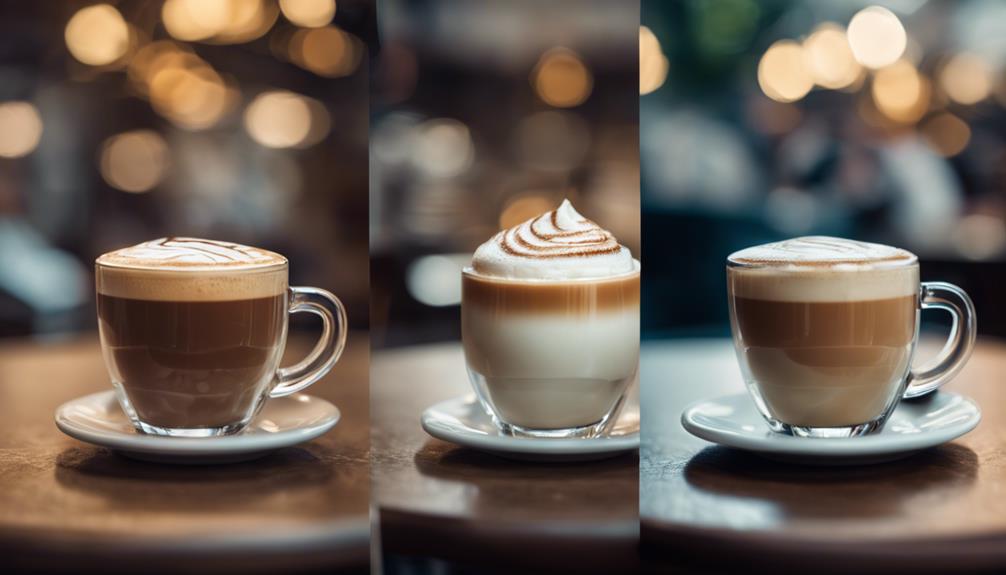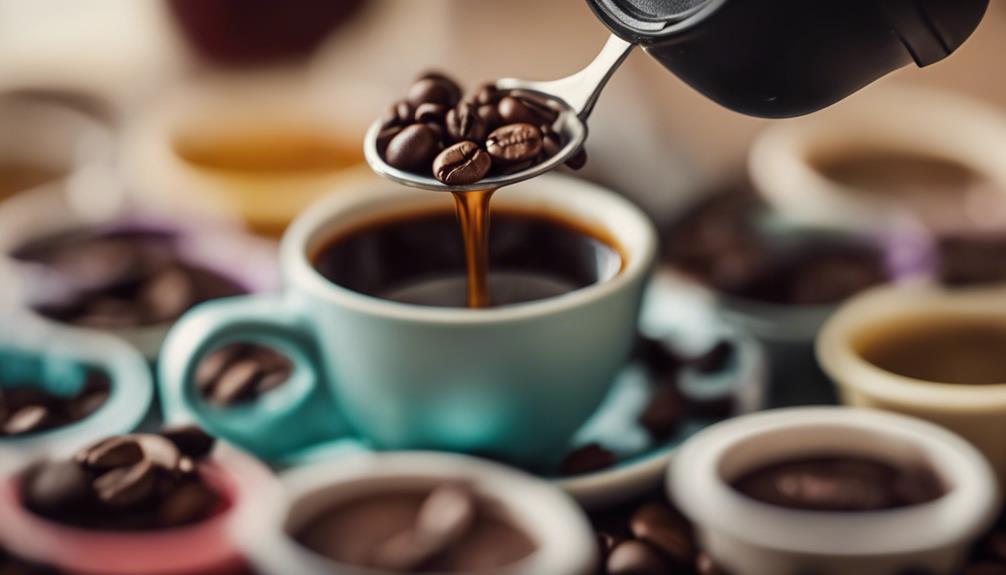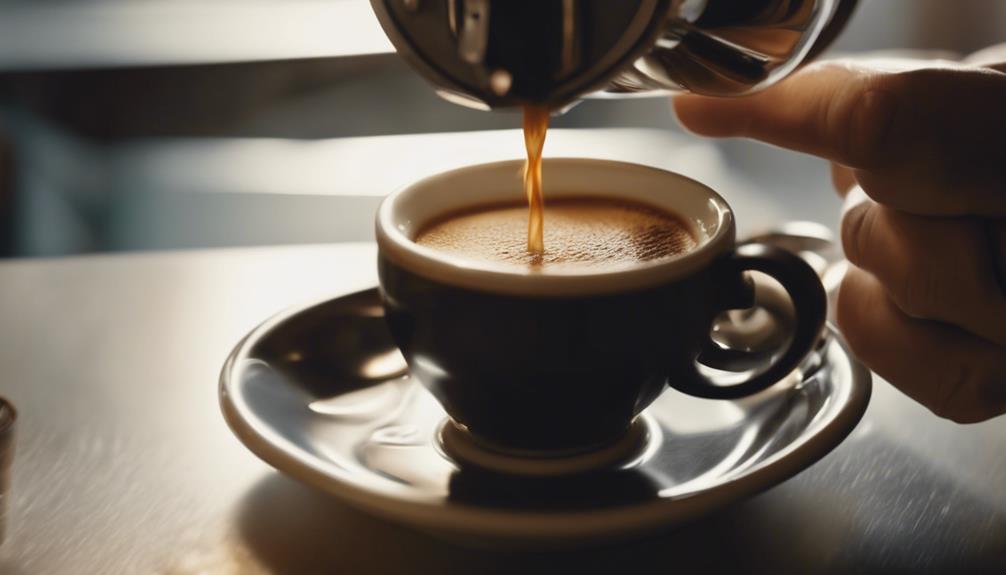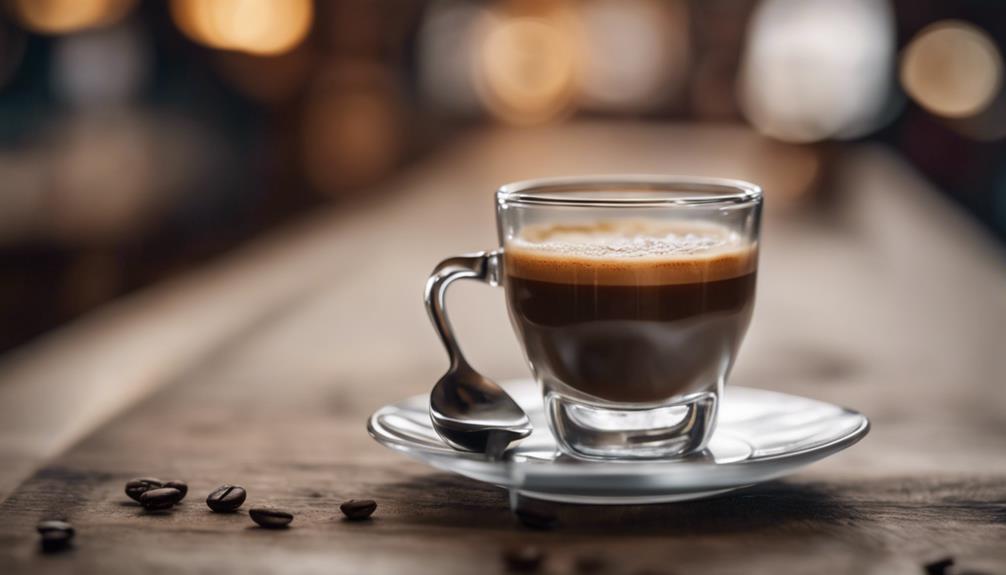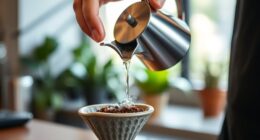When deciding between a shaken espresso and a latte, consider the key factors. Shaken espresso combines espresso, ice, milk, and syrup for a bold taste with a lighter texture. Lattes mix espresso, steamed milk, and foam for a creamier, milder option. The caffeine content is higher in shaken espresso, ideal for an energy boost. Lattes offer more milk choices, which can affect the taste and texture. Both beverages can be customized to your preferences. Take these factors into account when choosing between the two for your coffee fix.
Key Takeaways
- Shaken espresso offers a bolder, lighter drink with intense coffee flavors, while lattes provide a milder, creamier option.
- Shaken espresso has higher caffeine content, ideal for those seeking a robust energy boost, while lattes offer a moderate caffeine intake.
- Customization options like syrups and milk types impact flavor and texture differently in shaken espressos and lattes.
- Shaken espressos are visually appealing with frothy textures in small servings, while lattes are larger and creamier in presentation.
- Nutritional differences exist, with lattes containing more sugar, calcium, and proteins, while shaken espressos offer higher caffeine levels.
Ingredients and Preparation Methods
When comparing the ingredients and preparation methods of shaken espresso and latte, it's essential to understand the distinct differences in their composition and creation processes.
Shaken espresso typically consists of espresso, ice, milk, and syrup, while a latte combines espresso with steamed milk and foam. The preparation method for shaken espresso involves shaking these components together to create a frothy and chilled beverage, whereas a latte is traditionally made by pouring steamed milk over espresso.
In terms of customization options, shaken espresso often offers flavored syrups like caramel or vanilla to enhance the drink's taste, while lattes can be personalized with various milk alternatives and syrups for added sweetness.
Shaken espresso tends to have a higher espresso-to-milk ratio, resulting in a stronger coffee-forward flavor, whereas lattes provide a milder taste with a creamy texture due to the steamed milk. The shaking process in making espresso helps mellow the espresso's harshness, improving its overall taste, while lattes offer a smooth and velvety mouthfeel.
Taste and Flavor Profiles
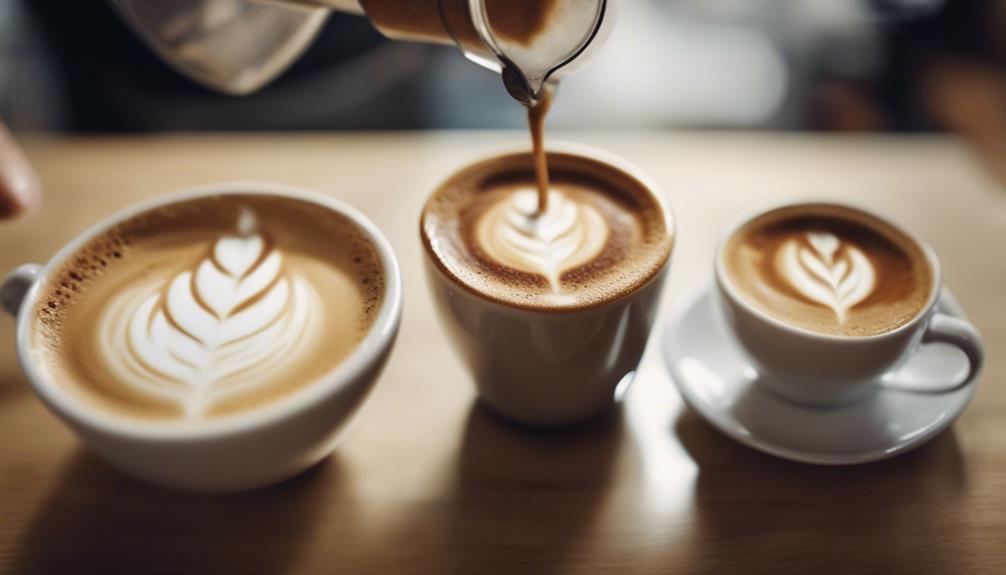
Comparing the taste and flavor profiles of shaken espresso and lattes reveals distinctive characteristics that cater to different preferences. Shaken espresso offers a bold flavor with a subtle sweetness derived from the shaking process, not added syrups. It has a lighter texture, thanks to the aeration during shaking, resulting in a frothy consistency that enhances the overall flavor profile. On the other hand, lattes present a milder taste, often available in sweetened variations. The choice of milk in a latte has a substantial impact on its texture and flavor, allowing for customization based on personal preferences. To better illustrate the differences in taste and flavor profiles between these two popular coffee drinks, refer to the table below:
| Aspect | Shaken Espresso | Latte |
|---|---|---|
| Flavor Profile | Bold, subtle sweetness | Milder, sweet options |
| Texture | Lighter, frothy | Creamy, smooth |
| Milk Choice | N/A | Substantial impact |
Understanding these key differences can help you decide which coffee drink aligns better with your taste preferences.
Caffeine Content Breakdown

The caffeine content breakdown between shaken espresso and lattes showcases notable differences in potency and energy levels. When it comes to your caffeine intake, here's what you need to know:
- Shaken espresso packs a punch with 150mg of caffeine in a grande size, providing a potent energy boost.
- Lattes, on the other hand, have varying caffeine content, ranging from 63-150mg per serving, making them a milder choice compared to shaken espresso.
- If you're looking for a strong caffeine kick, opt for shaken espresso, as it offers a more robust caffeine intake than traditional lattes.
- For a powerful coffee experience, go for the shaken espresso with 225mg of caffeine in a grande size, tailor-made for those seeking a potent caffeine boost.
Choose your brew wisely based on the level of energy you need to kickstart your day!
Milk Varieties and Options
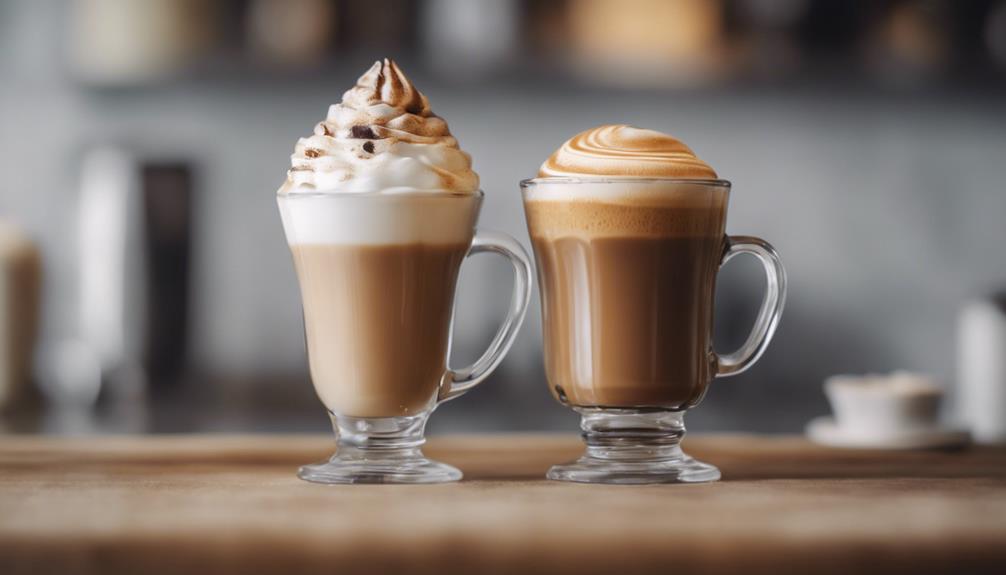
When comparing shaken espresso and lattes, the milk varieties and options play a significant role. You have choices like 2% milk, oatmilk, or almondmilk for shaken espresso, while lattes offer a broader selection including whole, skim, soy, or coconut milk.
Understanding these milk options allows you to customize your drink based on your preference for foam or a dairy alternative.
Foam or No Foam
Foam preferences in your coffee choice can greatly impact the overall texture and flavor profile of your drink. When deciding between foam or no foam in your latte or shaken espresso, consider the following:
- Lattes: Typically, lattes come with a luxurious layer of foam made from steamed milk, providing a creamy texture that enhances the overall drinking experience.
- Shaken Espresso: In contrast, shaken espresso tends to have minimal to no foam, allowing the intense coffee flavor to take center stage without the distraction of frothy milk.
- Customization: Foam in lattes adds a velvety mouthfeel that can be adjusted based on your preference, offering a personalized touch to your drink.
- Simplicity vs. Complexity: The absence of foam in shaken espresso creates a more straightforward and robust coffee experience, focusing solely on the bold flavors of the coffee beans themselves.
Dairy Alternatives
Curious about your milk options for your latte or shaken espresso at Starbucks? When it comes to dairy alternatives, Starbucks provides oat milk and almond milk to cater to customers with lactose intolerance or specific dietary preferences. These plant-based milk varieties offer a creamy texture and can be seamlessly substituted in your favorite shaken espresso or latte for a customized experience.
Oat milk, known for its richness, has gained popularity as a flavorful addition to coffee beverages. On the other hand, almond milk serves as another dairy alternative for those looking to avoid traditional dairy products. Whether you prefer the nutty taste of almond milk or the velvety smoothness of oat milk, Starbucks offers a range of dairy-free options to suit your preferences.
Syrups and Customization Choices
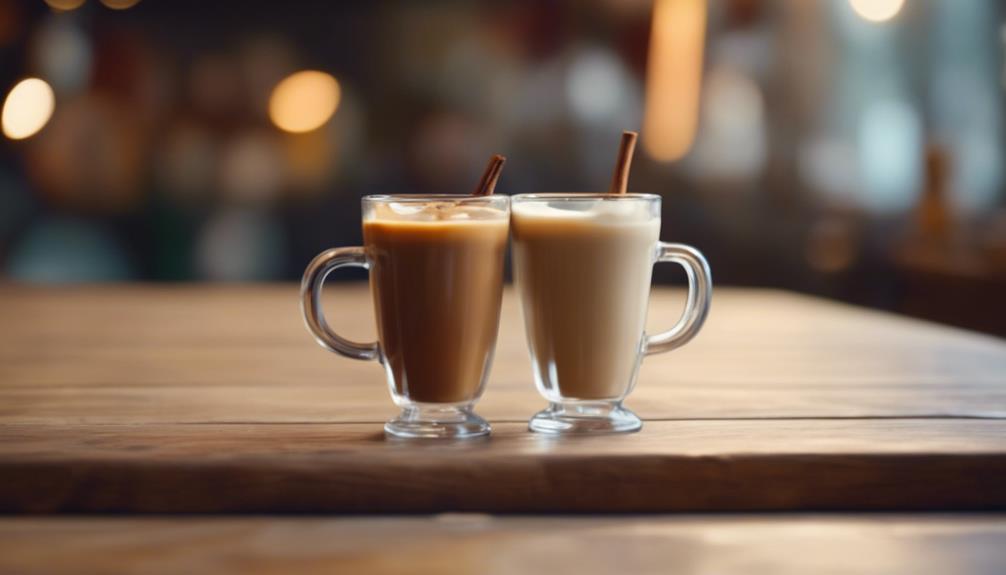
To enhance the flavor profiles of both shaken espresso and lattes, customization options include syrups like caramel, vanilla, or hazelnut for added sweetness. When customizing your drink, consider the following:
- Balancing Syrup Quantities: Adjusting the amount of syrup added is essential to harmonize with the strength of the coffee in both shaken espresso and lattes.
- Milk Alternatives: Experimenting with different milk alternatives such as oat, almond, or soy can lead to unique taste experiences in your customized beverages.
- Flavor Profiles: Syrups like vanilla and caramel can be chosen based on personal preferences to enhance the overall flavor profile of your drink.
- Customization Options: Whether you prefer a subtle hint of sweetness or a more pronounced flavor, the customization options available allow you to tailor your shaken espresso or latte to suit your individual taste preferences.
Serving Styles and Presentation

When comparing shaken espresso and lattes, it's important to note the distinct drink presentation styles. Shaken espresso is often served in smaller portions with a frothy texture, while lattes come in larger sizes with a creamy foam layer.
The serving vessel differences between the two beverages can greatly impact their visual appeal and overall presentation.
Drink Presentation Styles
The serving styles and presentation of shaken espresso and lattes vary in size and flavor intensity. When it comes to how these drinks are presented, here's what you can expect:
- Size: Shaken espresso is typically served in smaller 2-3 oz portions, offering a concentrated flavor that packs a punch. On the other hand, lattes are commonly found in larger sizes, with even the smallest servings starting at around 8 oz.
- Flavor Profile: Shaken espresso presents a more intense flavor profile due to its higher espresso content. If you prefer a coffee experience that's bold and strong, the shaken espresso might be the one for you.
- Texture: Lattes, with their steamed milk, offer a creamier and smoother texture, making them perfect for those who enjoy a milder coffee taste.
- Customization: Both drinks can be customized and presented in various sizes to suit individual preferences. Whether you like your coffee intense and small or creamy and large, there's an option for everyone.
Serving Vessel Differences
Serving vessel distinctions between shaken espresso and lattes are evident in their size variations, emphasizing the contrasting flavor experiences each drink offers. Shaken espresso is typically presented in a small 2-3 oz vessel, reflecting its concentrated flavor profile. The small vessel accentuates the drink's intense and robust coffee-forward characteristics, providing a potent taste experience for those who enjoy a strong coffee flavor.
On the other hand, lattes are commonly served in larger vessels, starting from 8 oz and increasing in size. This larger vessel allows for different milk-to-espresso ratios, catering to varied preferences for a creamier and milder coffee experience. The presentation of shaken espresso in a small vessel underscores its bold and flavorful nature, while the larger vessel used for lattes offers a more substantial drink with a focus on the balance between milk and espresso.
Visual Appeal Contrast
For a striking contrast in visual appeal between shaken espresso and lattes, consider their distinct serving styles and presentation techniques.
- Shaken espresso is typically served in small 2-3 oz portions, highlighting its concentrated and potent flavor.
- Lattes, on the other hand, are usually presented in larger servings, such as 8 oz, showcasing their creamy and milky composition.
- The visual appeal of shaken espresso comes from its frothy and chilled presentation, which emphasizes the unique shaking process.
- In contrast, lattes focus on the artful layering of espresso, steamed milk, and foam, offering a classic and comforting look.
Starbucks' offerings demonstrate these differences beautifully, catering to various preferences in serving styles.
Whether you prefer the intense and frothy charm of a shaken espresso or the creamy and comforting layers of a latte, the visual appeal of these drinks adds an extra dimension to the overall coffee experience.
Nutritional Comparison and Benefits

When considering the nutritional aspects of shaken espressos versus lattes, it's important to highlight the differences in sugar, calcium, proteins, and caffeine content.
Lattes generally contain more sugar, calcium, and proteins than shaken espressos. On the other hand, shaken espressos offer a higher caffeine content, providing an energy boost with around 225mg in a grande size.
The nutritional benefits vary between the two drinks, with lattes being less potent in caffeine but richer in certain nutrients. Shaken espressos, with their higher caffeine content, are ideal for a quick energy pick-me-up.
When making a choice between a shaken espresso and a latte, consider the nutritional values and caffeine levels to suit your preferences and needs. Whether you opt for the nutrient-rich latte or the potent caffeine kick of a shaken espresso, understanding the differences in sugar, calcium, proteins, and caffeine content can help you make an informed decision for your next coffee order.
Starbucks Menu Offerings

Among Starbucks' menu offerings, the selection of shaken espresso drinks stands out for its variety and customization options. When you visit Starbucks, you can enjoy the following options:
- Iced Shaken Espresso: A classic choice for espresso lovers seeking a revitalizing twist.
- Iced Brown Sugar Shaken Espresso: Perfect for those looking for a sweet and flavorful kick to their espresso.
- Customization Galore: Personalize your drink with different syrups like brown sugar syrup and various milk alternatives, including oatmilk.
- Plant-Based Expansion: Starbucks' commitment to plant-based options is evident with additions like the Iced Chocolate Almondmilk Shaken Espresso and the first oatmilk beverage, the Iced Brown Sugar Shaken Espresso, now on the permanent menu.
Whether you prefer your espresso iced, with a touch of sweetness, or fully customized with plant-based alternatives, Starbucks' shaken espresso offerings cater to a wide range of tastes and preferences.
Frequently Asked Questions
Is a Shaken Espresso Stronger Than a Latte?
A shaken espresso contains more shots of espresso than a latte, resulting in a higher caffeine content and a stronger taste profile. If you prefer a potent kick with robust coffee flavor, the shaken espresso is the way to go.
In contrast, lattes have a milder caffeine content due to fewer espresso shots and a higher proportion of milk. So, yes, a shaken espresso is indeed stronger than a latte when it comes to caffeine and taste intensity.
Does Shaken Espresso Taste Like a Latte?
Shaken espresso and latte have distinct flavors. While a shaken espresso boasts a bolder taste with frothy texture and a coffee-forward profile, a latte is creamier and sweeter due to more milk content.
Shaken espresso uses less milk and more espresso shots, resulting in a stronger coffee flavor. The subtle sweetness in a shaken espresso comes from simple syrup, while lattes may incorporate flavored syrups for sweetness.
What Is the Point of a Shaken Espresso?
The purpose of a shaken espresso lies in its ability to provide a revitalizing and lively twist to traditional coffee. By combining espresso shots, ice, simple syrup, and milk, shaking the mixture creates a frothy, chilled beverage with a lighter texture.
This process results in a less bitter flavor profile with a subtle sweetness, making it an appealing choice for those seeking a potent caffeine kick with a strong and intense flavor.
Is an Espresso Stronger Than a Latte?
Yes, an espresso is stronger than a latte due to its higher caffeine content.
Espresso is a concentrated coffee beverage made by forcing hot water through finely-ground coffee beans, resulting in a robust and intense flavor.
On the other hand, a latte is made by combining espresso with steamed milk, diluting the coffee's strength and creating a milder taste.
What Makes a Shaken Espresso Different from a Latte?
When it comes to espresso vs latte differences, the main distinction lies in the preparation. A shaken espresso is made by shaking together espresso shots, ice, and a flavored syrup, resulting in a frothy and refreshing beverage. On the other hand, a latte is made by pouring steamed milk over a shot of espresso, creating a creamy and smooth drink.
Conclusion
To sum up, when comparing shaken espresso and latte, both offer unique flavors and caffeine levels. While the shaken espresso is bold and intense, the latte is creamy and smooth.
Depending on your taste preferences and caffeine needs, either choice can satisfy your coffee cravings. Whether you prefer the sharp kick of the shaken espresso or the comforting warmth of a latte, Starbucks has a variety of options to please every coffee lover's palate.
